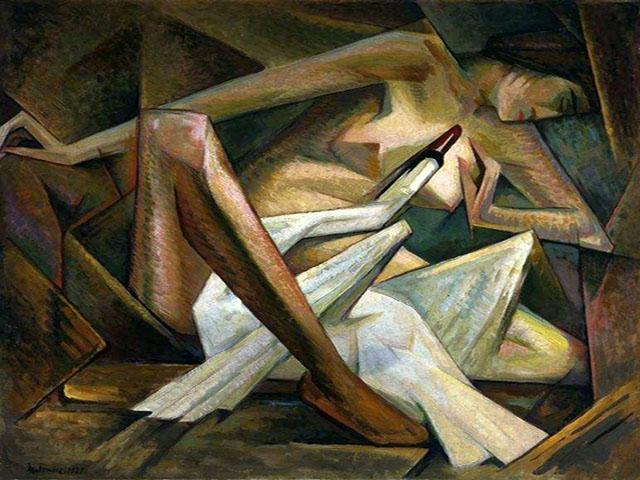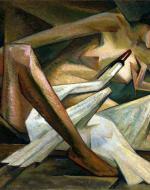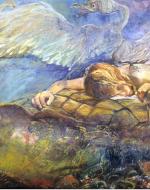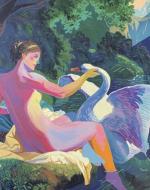Created by Abigail Ferris on Mon, 03/14/2022 - 23:32
Description:
Introduction
WB Yeats’s Leda and the Swan (1924) serves as an interpretation of the ancient Greek myth in which Zeus transforms into a swan for the purpose of assaulting or seducing Leda. This exhibit will focus on artistic interpretations of the Greek myth and how it relates to or rejects Yeats’s depictions of sexual oppression and violence; this gallery will also connect to the morally gray area that Yeats creates with his poem. While Zeus’s character is vital to the story Yeats desires to tell, Leda is the main focus of this exhibit as the poem relies on the audience to determine her agency: “And how can body, laid in that white rush, but feel the strange heart beating where it lies?”
Helen Sword directly confronts the different interpretations of sex in Yeats’s work, focusing on the contradictions between the male and female perspective of the audience. In Sword’s manuscript Leda and the Modernists, she summarizes the conflict between male and female interpretations with one sentence, particularly through a Modernist lens: “…the Leda myth offers a model of poetic creativity that is, particularly for male writers, as problematic as it is compelling” (305). While Sword doesn’t try to refute or outright deny the male perspective, her argument is in support of a female perspective and how women reading this myth and Yeats’s poem are in favor of Leda as a victim rather than gifted with “power through powerlessness” (306). Essentially, what in Yeats’s poem and in the ancient Greek myth typifies Leda as a victim and what classifies her as an unobjectionable participant?
Through images based on the myth and Yeats’s poem, this gallery serves to demonstrate how gender and time period affect the sexual themes of Leda and the Swan and their corresponding interpretations from 1924 to the present. Four of these artistic interpretations have been chosen because of their depictions of moral ambiguity, violence, or pleasure withing the myth and the poem and include artists of both genders and perspectives. This gallery features Modernist, Post-Modernist, Digital Print, and Contemporary versions of Yeats’s writing and answers to Leda’s victimhood or power gained through powerlessness.
Works Cited
Sword, Helen. “Leda and the Modernists.” PMLA, vol. 107, no. 2, Modern Language Association, 1992, pp. 305–18, https://doi.org/10.2307/462642.
Images in the Series
Figure 1. Jerzy Hulewicz, Leda and the Swan, 1928. National Museum, Warsaw, https://joyofmuseums.com/artists-index/leda-and-the-swan-in-art/.
Jerzy Hulewicz was a Polish Modernist artist, mainly focusing his art on the Expressionism movement within Modernism. This is one piece of many Expressionist pieces and depicts more ambiguous interpretations of Yeats’s poem and of the Greek myth. Unlike the other interpretations of the Yeats piece, Hulewicz focuses on the contrast between light and dark. Hulewicz draws the audience’s eye with the whiteness of Zeus as a swan and uses it as a focal point for the surroundings of the painting. While the swan is shown to be between Leda’s legs, the light shows the indecisiveness of body and the contrast between open and closed off body language. Instead of providing the viewer with a sense of confidence in Leda’s decisions, her arms and face contrast with how she is sitting and how her legs are positioned. This particular piece feels like it could go both ways in a few scenes and relies on the audience to determine if this is a violent or submissive depiction. While the other pieces in this gallery answer to either side of the argument, this piece ties into Yeats’s use of rhetorical questions that go unanswered.
Figure 2. Reuben Nakian, Leda and the Swan, 1981. Cavalier Galleries, https://www.cavaliergalleries.com/exhibition/22/exhibition_works/1787.
This image is featured in an online catalogue of the Cavalier Galleries and includes a handful of other works by Nakian, focusing on Leda and the Swan as well as other myths and magical creatures. While many interpretations of the sex between Leda and Zeus are decidedly neutral, Nakian illustrates a consensual and pleasurable experience between the god and Leda. The Post-Modernist approach leaves the viewer with little to be distracted by and the lack of color encourages attention to lines, shading, and shapes. This image shows Leda spread for the viewer and for Zeus, allowing and finding enjoyment from oral sex from him. Her form in the image is relaxed and ties into how Yeats writes Leda as caught up in the moment of this sexual act. It’s also important to recognize that this consensual depiction of the pair follows the male perspective and how Leda gains power from Zeus instead of losing her innocence and agency.
Figure 3. Jessica Damen, Leda and the Angry Swan, 2017. Jessica Damen Fine Art Studio, https://damenart.com/artwork/4157376-Leda-and-the-Angry-Swan.html.
While the other three pieces in this gallery demonstrate a pleasurable or ambiguous experience for Leda, Damen instead demonstrates Leda’s pain and loss of power in her struggle with Zeus. This digital art piece shows a direct contrast between Leda’s human form and Zeus’s swan form, bathing the god in a heavenly light and leaving Leda in the earthy environment of a darker color palette. While the other images focus on Leda’s and Zeus’s bodies, this image instead draws the viewer to Leda’s eye as if she is watching the audience as a bystander to this violent act. The artist herself explains her decision in depicting the myth: “The myth’s recasting images, whether pruriently imagined or disguised as ‘divine’ sensual rapture, are from a male perspective…The viewer cannot escape her gaze and the window to her soul. She is overpowered, not subdued. This Swan-Zeus is not a loving ‘divine spirit,’ but a rather territorial, aggressive being.” Unlike the male interpretations of Greek myth, Damen connects to the shared feminine opinion on the piece, stating that Leda isn’t gaining power from this violent act; rather, she is a victim to a situation she cannot control.
Figure 4. Andy Dixon, Leda and the Swan Painting, 2021. New Union Gallery, https://www.artsy.net/artwork/andy-dixon-andy-dixon-leda-and-the-swan-painting-24-color-screen-print-contemporary-art-urban.
With vibrant colors, Dixon puts his own spin on his interpretation of the Greek myth and previous Renaissance portraits and still-life paintings in his piece. As the most “modern” of the four in this gallery, this interpretation views Leda and the Swan as a pleasurable experience for Zeus and Leda; using body language, facial expressions, and the positions of the subjects in relation to the surroundings of the artwork, Dixon demonstrates a consensual relationship between the pair rather than a sexually violent one. Instead of depicting Zeus as the seducer in many other interpretations, Dixon portrays Leda as the seducer and ties into the male perspective of taking power from a powerless situation and circumstance. The warm colors Leda is displayed in draws the eye of the viewer and is automatically the focal point of the piece. While it’s clear that Zeus is giving off his own kind of seductive body language, it seems as though it is a reaction to Leda rather than the opposite. This piece ties into Yeats’s work in that Leda perfectly depicts how Yeats characterizes her as a master of the “brute blood of the air;” her masterful position in turn becomes her sexual power and dominance in this interpretation.





